Sapindales
plant order
Introduction
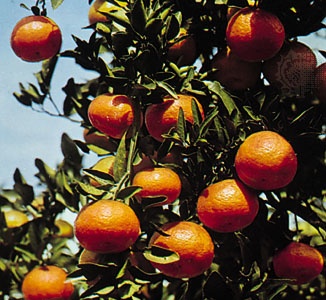 order of dicotyledonous flowering plants, containing 9 families, about 460 genera, and some 5,700 species of shrubs, woody vines, and trees. It includes the Citrus genus and other species important for their fruits.
order of dicotyledonous flowering plants, containing 9 families, about 460 genera, and some 5,700 species of shrubs, woody vines, and trees. It includes the Citrus genus and other species important for their fruits.More than half the species in Sapindales belong to two families: Sapindaceae (about 1,600 species) and Rutaceae (about 1,800 species). Most of the remaining species belong to four other well-known families: Anacardiaceae (about 600 species), Burseraceae (550 species), Meliaceae (621 species), and Simaroubaceae (95 species). The remaining three families (Biebersteiniaceae, Kirkiaceae, and Nitrariaceae) total 27 species.
Sapindales is placed in the Rosid II group, along with Huerteales, Malvales, and Brassicales, in the Angiosperm Phylogeny Group II botanical classification system (see angiosperm).
Distribution and abundance
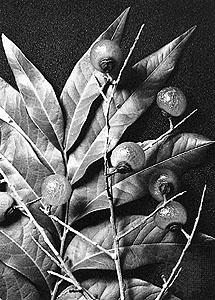 Sapindaceae, or the soapberry family, with about 135 genera and some 1,600 species, occurs mainly in the tropical areas of the world and is especially abundant in the American tropics. Species range from trees and shrubs to lianas (liana) or herbaceous vines. The family is found throughout the wetter tropics and subtropics, extending north to Japan and south to New Zealand. The largest genera in the family are Serjania (215 species), which occurs from the southern United States to tropical South America and has a main centre of diversity in southeastern Brazil, and Paullinia (195 species) in the American tropics and subtropics. Both are lianas or vines. Allophylus is a tropical and subtropical genus of shrubs and trees, with anywhere from 1 to 200 species recognized by some botanists.
Sapindaceae, or the soapberry family, with about 135 genera and some 1,600 species, occurs mainly in the tropical areas of the world and is especially abundant in the American tropics. Species range from trees and shrubs to lianas (liana) or herbaceous vines. The family is found throughout the wetter tropics and subtropics, extending north to Japan and south to New Zealand. The largest genera in the family are Serjania (215 species), which occurs from the southern United States to tropical South America and has a main centre of diversity in southeastern Brazil, and Paullinia (195 species) in the American tropics and subtropics. Both are lianas or vines. Allophylus is a tropical and subtropical genus of shrubs and trees, with anywhere from 1 to 200 species recognized by some botanists.Included within Sapindaceae are the genera from two former families, Aceraceae and Hippocastanaceae. The most important genus in Aceraceae was Acer ( maple), with about 110 species, which is found across the north temperate zone from western North America to Japan. Maple trees form an important component of the deciduous forests of North America, Europe, and Asia. The distribution of the genus dips southward to Guatemala and through Southeast Asia to Malaysia and the Philippines, where species may be abundant in tropical mountain forests. The major centre of distribution for the genus is China, where half the maple species occur; about three-quarters of the species are Asian. There are eight species of Acer with compound leaves that are sometimes placed in a separate genus, Negundo. Another former member of Aceraceae is Dipteronia, a genus of central and southern China with two species.
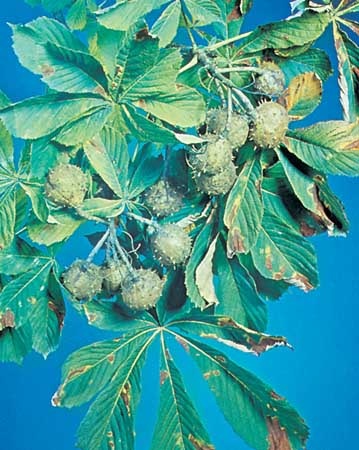 Hippocastanaceae had only two genera of trees and shrubs. Aesculus (horse chestnuts (horse chestnut) and buckeyes (buckeye)), with about 13 deciduous species, has an interrupted distribution in temperate forests from western and eastern North America (seven species) to the Balkan Peninsula in Europe (one species) and in Asia from India to China and Japan (five species). The two evergreen species of Billia occur as isolated trees in tropical forests from southern Mexico to northern South America.
Hippocastanaceae had only two genera of trees and shrubs. Aesculus (horse chestnuts (horse chestnut) and buckeyes (buckeye)), with about 13 deciduous species, has an interrupted distribution in temperate forests from western and eastern North America (seven species) to the Balkan Peninsula in Europe (one species) and in Asia from India to China and Japan (five species). The two evergreen species of Billia occur as isolated trees in tropical forests from southern Mexico to northern South America. Rutaceae, or the Citrus, or rue, family, consists of shrubs, trees, and a few herbs. It has about 160 genera and some 1,800 species, which are widespread in distribution but occur primarily in tropical and warm temperate areas. The largest numbers of genera and species are found in southern Africa and Australia. Many of these grow in semiarid woodlands. The largest genus, Zanthoxylum (about 250 species), occurs in temperate North America and East Asia and throughout the tropics. Melicope (about 150 species, including the former genus Pelea) occurs from Indo-Malaysia through Australia and New Zealand to the Pacific Islands. Agathosma (135 species) is endemic to South Africa. Boronia (about 100 species) is one of the largest endemic Australian genera. Haplophyllum (about 70 species) occurs from the Mediterranean region to eastern Siberia.
Rutaceae, or the Citrus, or rue, family, consists of shrubs, trees, and a few herbs. It has about 160 genera and some 1,800 species, which are widespread in distribution but occur primarily in tropical and warm temperate areas. The largest numbers of genera and species are found in southern Africa and Australia. Many of these grow in semiarid woodlands. The largest genus, Zanthoxylum (about 250 species), occurs in temperate North America and East Asia and throughout the tropics. Melicope (about 150 species, including the former genus Pelea) occurs from Indo-Malaysia through Australia and New Zealand to the Pacific Islands. Agathosma (135 species) is endemic to South Africa. Boronia (about 100 species) is one of the largest endemic Australian genera. Haplophyllum (about 70 species) occurs from the Mediterranean region to eastern Siberia.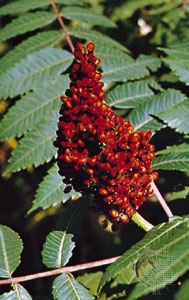 Anacardiaceae, or the sumac family, consists of 70 genera and about 600 species of trees, shrubs, and woody vines. They occur mostly in the tropics and subtropics, but a few genera extend into both the north and south temperate zones. The largest genus by far is Rhus, with about 200 species in the subtropics and temperate areas of the world. (Although some botanists prefer a narrow circumscription for the genus, in which case it contains only about 35 species.) There are no other genera of comparable size, but Semecarpus (occurring from Indo-Malaysia to Micronesia) has about 60 species, Mangifera (occurring in Southeast Asia and Indo-Malaysia to Solomon Islands) has about 40 species, and Schinus (occurring from Mexico to Argentina) has about 30 species.
Anacardiaceae, or the sumac family, consists of 70 genera and about 600 species of trees, shrubs, and woody vines. They occur mostly in the tropics and subtropics, but a few genera extend into both the north and south temperate zones. The largest genus by far is Rhus, with about 200 species in the subtropics and temperate areas of the world. (Although some botanists prefer a narrow circumscription for the genus, in which case it contains only about 35 species.) There are no other genera of comparable size, but Semecarpus (occurring from Indo-Malaysia to Micronesia) has about 60 species, Mangifera (occurring in Southeast Asia and Indo-Malaysia to Solomon Islands) has about 40 species, and Schinus (occurring from Mexico to Argentina) has about 30 species. Burseraceae, or the frankincense family, has 18 genera and 550 species of trees and shrubs. The family occurs throughout the tropics and is especially common in tropical America and northeastern Africa, Madagascar, and the Arabian Peninsula. Many species dominate the forests or woodlands in which they grow. The largest genus, Commiphora (190 species), is found mostly in the drier areas of northeastern Africa, Madagascar, and from Arabia to India. Protium (85 species) occurs mostly in wet lowland areas of tropical America but with a few species in Madagascar and Malaysia. Canarium (pili nut) (75 species) occurs in the forests of the Old World tropics. Bursera (50 species) is found in tropical America, with its centre of diversity in Mexico.
Meliaceae, or the mahogany family, has 52 genera and 621 species of trees, shrubs, and a few perennial herbs. Many are large, widespread, and common or dominant trees in tropical and subtropical primary and secondary forests, with only a few species in temperate areas. About two-thirds of the species occur in the six largest genera: Aglaia (110 species) in Indo-Malaysia and tropical Australia; Trichilia (85 species), which occur commonly as understory trees in lowland forests from Mexico to the West Indies, tropical South America, and tropical Africa; Dysoxylum (80 species) from Indo-Malaysia to the islands of the Pacific; Turraea (60 species) in tropical and southern Africa to Australia; Chisocheton (50 species) in Indo-Malaysia; and Guarea (50 species) in tropical America and tropical Africa.
Simaroubaceae, or the quassia family, consists of 19 genera and 95 species of trees and shrubs that are mostly tropical in distribution. Quassia, with 40 species in the rainforests of tropical America and Africa, contains trees and shrubs that are the source of bitter-tasting compounds used as a vermifuge (to kill intestinal worms) and as insecticides.
Economic and ecological importance
Sapindaceae
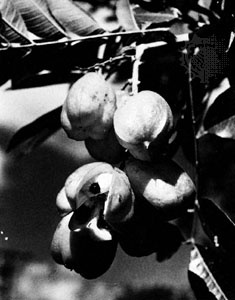 Many members of the order are important economically, particularly for their timber or fruits. A few tropical species of the family Sapindaceae produce useful wood for construction, furniture, or fuel, but many are better known for their fruits. Blighia sapida ( akee) from West Africa, Pappea capensis (wild prune) from tropical and southern Africa, and Pometia pinnata from New Guinea are the larger trees of the family that provide timber. Akee and Pometia also have edible fruits. Akee, which looks and tastes like scrambled eggs when cooked, is the national fruit of Jamaica, where it is widely grown and eaten; it is, however, poisonous if not cooked at the correct stage of ripeness—i.e., after the fruit has opened naturally and is still fresh. Only the fleshy aril around the seed is eaten.
Many members of the order are important economically, particularly for their timber or fruits. A few tropical species of the family Sapindaceae produce useful wood for construction, furniture, or fuel, but many are better known for their fruits. Blighia sapida ( akee) from West Africa, Pappea capensis (wild prune) from tropical and southern Africa, and Pometia pinnata from New Guinea are the larger trees of the family that provide timber. Akee and Pometia also have edible fruits. Akee, which looks and tastes like scrambled eggs when cooked, is the national fruit of Jamaica, where it is widely grown and eaten; it is, however, poisonous if not cooked at the correct stage of ripeness—i.e., after the fruit has opened naturally and is still fresh. Only the fleshy aril around the seed is eaten.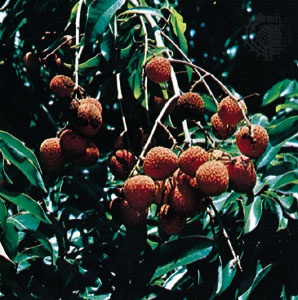 Other popular tropical fruits from Sapindaceae come from Litchi chinensis ( litchi), Dimocarpus longan ( longan), Nephelium lappaceum ( rambutan), and Aphania senegalensis (Senegal cherry) from the Old World and Melicoccus bijugatus (mamoncillo) from the New World. Many of these are widely cultivated.
Other popular tropical fruits from Sapindaceae come from Litchi chinensis ( litchi), Dimocarpus longan ( longan), Nephelium lappaceum ( rambutan), and Aphania senegalensis (Senegal cherry) from the Old World and Melicoccus bijugatus (mamoncillo) from the New World. Many of these are widely cultivated.Useful oils are expressed from the seeds of wild prune and Schleichera oleosa (Ceylon oak); the latter is the source of macassar oil, and this species harbours Laccifer lacca, the insect that produces lac, a resinous excretion that is a source of shellac.
The seeds of the Brazilian and Paraguayan vine Paullinia cupana ( guarana) are ground to make a beverage that contains three times as much caffeine as found in a cup of coffee; a stimulating tea used in pre-Columbian South America, guarana became a popular ingredient in energy drinks beginning in the 20th century. The bark of Paullinia yoco (yoco) has similar stimulant properties.
 The fruits of Sapindus saponaria (soapberry), a tropical American species, contain saponins (saponin) (chemical substances that produce soapy lather in water) and are used as soap. The genus name Sapindus means “soap of the Indians.” A number of members of Sapindaceae have saponins in their tissues. In the American tropics the indigenous peoples sometimes crush the leaves and branches of Paullinia, Serjania, and related genera and throw them into pools or small streams to stun fish.
The fruits of Sapindus saponaria (soapberry), a tropical American species, contain saponins (saponin) (chemical substances that produce soapy lather in water) and are used as soap. The genus name Sapindus means “soap of the Indians.” A number of members of Sapindaceae have saponins in their tissues. In the American tropics the indigenous peoples sometimes crush the leaves and branches of Paullinia, Serjania, and related genera and throw them into pools or small streams to stun fish.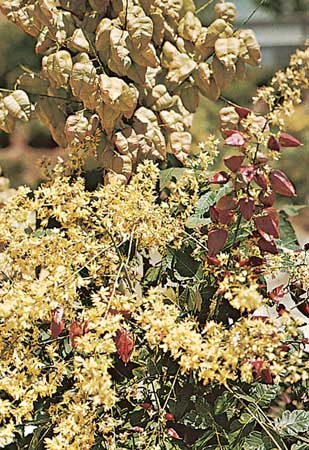 A few species of Sapindaceae are grown as ornamentals. Koelreuteria paniculata ( goldenrain tree), a small tree from China, Korea, and Japan, is commonly cultivated in temperate regions for its large pyramidal clusters of yellow flowers and conspicuous bladderlike fruits. Cardiospermum halicacabum ( balloon vine), an annual from the tropics and subtropics, is grown for its small balloonlike fruits in many areas, where it sometimes escapes and becomes naturalized. Dodonaea viscosa (hopbush), a widespread tropical shrub, is cultivated in warmer areas for its colourful foliage. Akee is grown not only for its fruits but also as a shade tree.
A few species of Sapindaceae are grown as ornamentals. Koelreuteria paniculata ( goldenrain tree), a small tree from China, Korea, and Japan, is commonly cultivated in temperate regions for its large pyramidal clusters of yellow flowers and conspicuous bladderlike fruits. Cardiospermum halicacabum ( balloon vine), an annual from the tropics and subtropics, is grown for its small balloonlike fruits in many areas, where it sometimes escapes and becomes naturalized. Dodonaea viscosa (hopbush), a widespread tropical shrub, is cultivated in warmer areas for its colourful foliage. Akee is grown not only for its fruits but also as a shade tree.The best-known member of the previously recognized family Aceraceae is Acer saccharum ( sugar maple). It has sugar-rich sap that is tapped in the early spring in eastern North America in order to make maple syrup and maple sugar. Sugar maple has been described as the most valuable hardwood in North America. Its figured wood (curly maple and bird's-eye maple) is valued for cabinetry and furniture; the plain wood is used for construction, flooring, and interior finish. The hard, strong, heavy close-grained wood is often beautifully patterned. The sugar maple is a valuable ornamental and shade tree because of its thick shapely crown and the bright yellow, orange, and red autumnal coloration. In addition, it yields valuable firewood. Other North American maple species are less important as timber, paper pulp, sugar-producing, and ornamental trees. A few European species, and more Asian species, are sources of timber or grown as ornamentals for their foliage and leaf colours.
 Next to the maples within Sapindaceae, members of the previously recognized family Hippocastanaceae probably have the most economic significance in temperate areas, in spite of their small numbers. Aesculus hippocastanum ( horse chestnut) of the Balkan mountain region and the North American buckeyes (buckeye)—A. glabra (Ohio buckeye) and A. flava (yellow buckeye)—have light, soft, tough fine-grained wood. Once used for artificial limbs, splints, and various kinds of woodware, the wood is now most important as a source of paper pulp. The leaves and seeds are poisonous, and extracts from them are employed by certain indigenous peoples to stun fish. Selected varieties and hybrids of Aesculus are frequently cultivated as ornamentals for their flowers or foliage or as shade trees.
Next to the maples within Sapindaceae, members of the previously recognized family Hippocastanaceae probably have the most economic significance in temperate areas, in spite of their small numbers. Aesculus hippocastanum ( horse chestnut) of the Balkan mountain region and the North American buckeyes (buckeye)—A. glabra (Ohio buckeye) and A. flava (yellow buckeye)—have light, soft, tough fine-grained wood. Once used for artificial limbs, splints, and various kinds of woodware, the wood is now most important as a source of paper pulp. The leaves and seeds are poisonous, and extracts from them are employed by certain indigenous peoples to stun fish. Selected varieties and hybrids of Aesculus are frequently cultivated as ornamentals for their flowers or foliage or as shade trees. Meliaceae
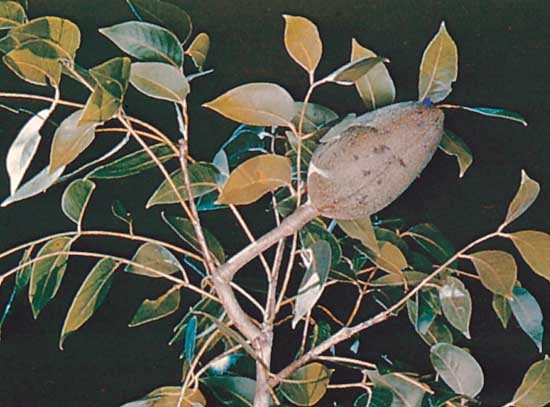 Many tropical species of the family Meliaceae are important timber trees. The best known, Swietenia mahagoni (West Indian mahogany (mahogany)), is one of the world's most valuable woods. Swietenia macrophylla (Honduras mahogany), from Mexico to Bolivia, is also well known. Other valuable timbers of Meliaceae from the American tropics are derived from species of Cedrela; C. odorata (West Indian cedar), for example, is the source of wood used for making cigar boxes.
Many tropical species of the family Meliaceae are important timber trees. The best known, Swietenia mahagoni (West Indian mahogany (mahogany)), is one of the world's most valuable woods. Swietenia macrophylla (Honduras mahogany), from Mexico to Bolivia, is also well known. Other valuable timbers of Meliaceae from the American tropics are derived from species of Cedrela; C. odorata (West Indian cedar), for example, is the source of wood used for making cigar boxes.The six or seven species of Khaya in tropical Africa and Madagascar, including K. senegalensis (African mahogany), produce a wood like that of mahogany, as do the nine species of omu, sapele, and utile mahoganies (Entandrophragma). Important Asian timber trees are Toona ciliata (Australian red cedar, or Indian mahogany; grown throughout South Asia, New Guinea, and Australia), Chukrasia tabularis (Chittagong wood; grown in China and Indo-Malaysia), and Soymida febrifuga (Indian redwood; grown in Indo-Malaysia). Dysoxylum fraserianum (Australian mahogany) is a timber tree of the forests of northern and eastern Australia. The wood of these genera, all of Meliaceae, is typically reddish in colour, lustrous, easy to work, and free of warping under changes in relative humidity. Such characteristics make the wood highly suited for cabinetmaking.
Some species of Meliaceae have medicinal properties. The bark of the Indo-Malaysian Azadirachta indica (neem) is astringent and may also be used to make an insecticide. The bark of Guarea rusbyi (cocillana) from South America is an emetic. The seeds of other species yield useful oils. Several species of Carapa produce oils used for soap: in South America C. guianensis (crabwood), in Indo-Malaysia C. procera, and in East Africa Trichilia emetica (cape mahogany). The seeds of the Malayan Chisocheton macrophyllus are a source of an oil used for burning in lamps.
A few members of Meliaceae have edible fruits. Popular in Southeast Asia are Lansium domesticum (langsat) and Sandoricum koetjape (santol), while the flowers of Aglaia odorata are used in East Asia to flavour tea. Melia azedarach (chinaberry, or China tree), a Himalayan tree, is widely grown as an ornamental and is particularly common in the southeastern United States. It has clusters of fragrant lilac-coloured flowers and attractive but poisonous yellow berries.
Rutaceae
 As with Sapindaceae, members of Rutaceae are best known for their fruits. Citrus is the most important genus in the family; its fruits are an important source of vitamin C. A genus of small evergreen trees from South China to Indo-Malaysia, Citrus species are now cultivated throughout the warm temperate and tropical areas of the world, especially Citrus aurantifolia ( lime), C. aurantium (Seville orange), C. limon ( lemon), C. medica ( citron), C. nobilis (mandarin orange), C. paradisi ( grapefruit), C. reticulata ( tangerine), and C. sinensis (sweet orange). A few other genera also yield edible fruits. Aegle marmelos ( bel fruit), Fortunella japonica ( kumquat), and Limonia acidissima (elephant apple) have fruits that are widely eaten, while those of Zanthoxylum piperitum (Japanese pepper) are used as a condiment.
As with Sapindaceae, members of Rutaceae are best known for their fruits. Citrus is the most important genus in the family; its fruits are an important source of vitamin C. A genus of small evergreen trees from South China to Indo-Malaysia, Citrus species are now cultivated throughout the warm temperate and tropical areas of the world, especially Citrus aurantifolia ( lime), C. aurantium (Seville orange), C. limon ( lemon), C. medica ( citron), C. nobilis (mandarin orange), C. paradisi ( grapefruit), C. reticulata ( tangerine), and C. sinensis (sweet orange). A few other genera also yield edible fruits. Aegle marmelos ( bel fruit), Fortunella japonica ( kumquat), and Limonia acidissima (elephant apple) have fruits that are widely eaten, while those of Zanthoxylum piperitum (Japanese pepper) are used as a condiment.The fruits of Aegle are used medicinally, as are those of Poncirus trifoliata (Chinese hardy orange). Many species of Rutaceae have bitter bark that is medicinal, including the tropical American Angostura febrifuga (angostura) and Galipea officinalis (casparia). The bark of several North American species of Zanthoxylum is chewed for toothache relief.
 Essential oils (essential oil) found in the tissues of Rutaceae are the source of the characteristic flavours of fruits, bark, gums, and leaves. The leaves of Ruta graveolens ( rue) are a flavouring herb in Europe, and oil of rue is distilled from them. Leaves of Murraya koenigii (curry leaf) are used in curries. Citrus oils are commonly expressed from the rinds of different citrus fruits or from their flowers. Perhaps the best known is oil of neroli from the Seville orange, widely used in perfumery in France.
Essential oils (essential oil) found in the tissues of Rutaceae are the source of the characteristic flavours of fruits, bark, gums, and leaves. The leaves of Ruta graveolens ( rue) are a flavouring herb in Europe, and oil of rue is distilled from them. Leaves of Murraya koenigii (curry leaf) are used in curries. Citrus oils are commonly expressed from the rinds of different citrus fruits or from their flowers. Perhaps the best known is oil of neroli from the Seville orange, widely used in perfumery in France. A few species of Rutaceae are grown as ornamentals in temperate regions. Poncirus is a spiny hedge shrub; Skimmia japonica (Japanese skimmia) and S. reevesiana (Chinese skimmia) have white flowers and red berries; the North American Ptelea trifoliata ( hop tree) has attractive winged fruits; and the northeast Asian Phellodendron amurense (Amur cork tree) is a valuable shade tree. Dictamnus albus (gas plant) ( burning bush) is one of the few members of the family that is not woody. This poisonous perennial herb, native from southern Europe to northern China, is grown not only for its attractive whitish flowers but also for its ethereal oil; the glands of this plant can be squeezed and the oil expressed into the air and ignited by a match—hence the common name.
A few species of Rutaceae are grown as ornamentals in temperate regions. Poncirus is a spiny hedge shrub; Skimmia japonica (Japanese skimmia) and S. reevesiana (Chinese skimmia) have white flowers and red berries; the North American Ptelea trifoliata ( hop tree) has attractive winged fruits; and the northeast Asian Phellodendron amurense (Amur cork tree) is a valuable shade tree. Dictamnus albus (gas plant) ( burning bush) is one of the few members of the family that is not woody. This poisonous perennial herb, native from southern Europe to northern China, is grown not only for its attractive whitish flowers but also for its ethereal oil; the glands of this plant can be squeezed and the oil expressed into the air and ignited by a match—hence the common name.Only a few species of Rutaceae are important timber trees. The Indo-Malaysian Chloroxylon swietenia ( satinwood), eastern Australian Flindersia oxleyana (Australian yellowwood), and Caribbean Zanthoxylum flavum (West Indian silkwood) are used for veneering and cabinetmaking.
Anacardiaceae
 Anacardiaceae, like Rutaceae and Sapindaceae, is known for its fruits. Anacardium occidentale ( cashew), a tropical South American tree, was one of the first fruit trees to be distributed throughout the tropics by early Spanish and Portuguese adventurers. The seed produces the cashew nut, while the reddish swollen axis under the fruit proper is the cashew apple. The former is roasted and eaten, while the latter is crushed, strained, and added to water and sugar to make a refreshing drink consumed throughout tropical America.
Anacardiaceae, like Rutaceae and Sapindaceae, is known for its fruits. Anacardium occidentale ( cashew), a tropical South American tree, was one of the first fruit trees to be distributed throughout the tropics by early Spanish and Portuguese adventurers. The seed produces the cashew nut, while the reddish swollen axis under the fruit proper is the cashew apple. The former is roasted and eaten, while the latter is crushed, strained, and added to water and sugar to make a refreshing drink consumed throughout tropical America. Mangifera indica ( mango), native to Indo-Malaysia, is cultivated throughout the tropics. The fruit of this large tree has a thick, aromatic, tasty flesh; it has been called the queen of the tropical fruits. Several species of the tropical genus Spondias (such as hog plum) are cultivated for their fleshy fruits, eaten fresh or cooked. Pistacia vera (pistachio nut) is a temperate tree, native from the Mediterranean to Afghanistan but now also cultivated in North America for its edible seeds.
Mangifera indica ( mango), native to Indo-Malaysia, is cultivated throughout the tropics. The fruit of this large tree has a thick, aromatic, tasty flesh; it has been called the queen of the tropical fruits. Several species of the tropical genus Spondias (such as hog plum) are cultivated for their fleshy fruits, eaten fresh or cooked. Pistacia vera (pistachio nut) is a temperate tree, native from the Mediterranean to Afghanistan but now also cultivated in North America for its edible seeds.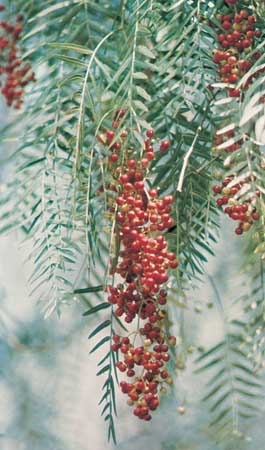 Schinus molle (Peruvian pepper tree) has fruits that are not eaten directly, but they are the source of a fermented alcoholic drink. This is a commonly grown ornamental in subtropical America, where it has also become naturalized and quite a scourge in places such as Florida. It is grown for its feathery, evergreen, compound leaves and red berries (on the female trees), and it is very tolerant of dry habitats and poor soils. A related species from Brazil, Schinus terebinthifolius (Brazilian pepper tree), is also widely grown in tropical regions and is the commercial source of pink peppercorns. Although these are sometimes sold in mixes with Piper nigrum ( black pepper), they are totally unrelated, and care should be taken with Schinus fruits, given the toxic compounds prevalent in so many members of Anacardiaceae. Semecarpus anacardium (dhobi nut) has young fruits with a black resin that is insoluble in water and is used as a marking ink in Southeast Asia.
Schinus molle (Peruvian pepper tree) has fruits that are not eaten directly, but they are the source of a fermented alcoholic drink. This is a commonly grown ornamental in subtropical America, where it has also become naturalized and quite a scourge in places such as Florida. It is grown for its feathery, evergreen, compound leaves and red berries (on the female trees), and it is very tolerant of dry habitats and poor soils. A related species from Brazil, Schinus terebinthifolius (Brazilian pepper tree), is also widely grown in tropical regions and is the commercial source of pink peppercorns. Although these are sometimes sold in mixes with Piper nigrum ( black pepper), they are totally unrelated, and care should be taken with Schinus fruits, given the toxic compounds prevalent in so many members of Anacardiaceae. Semecarpus anacardium (dhobi nut) has young fruits with a black resin that is insoluble in water and is used as a marking ink in Southeast Asia. Other species of Anacardiaceae are also grown as ornamentals. Cotinus coggygria ( smoke tree), from southern Europe to central China, is a shrub with purplish foliage and large diffuse inflorescences that give the “smoky” appearance. It is commonly planted in temperate regions. Several species of Rhus ( sumac), particularly those from North America, are cultivated as shrubs, especially for their colourful reddish autumn foliage.
Other species of Anacardiaceae are also grown as ornamentals. Cotinus coggygria ( smoke tree), from southern Europe to central China, is a shrub with purplish foliage and large diffuse inflorescences that give the “smoky” appearance. It is commonly planted in temperate regions. Several species of Rhus ( sumac), particularly those from North America, are cultivated as shrubs, especially for their colourful reddish autumn foliage.Few Anacardiaceae species have had their wood exploited for building or for cabinetmaking; however, many of them have valuable tannins (tannin) that have been extracted for tanning leather. Schinopsis quebracho-colorado (quebracho) is a major source of tannins in South America, as is Rhus coriaria (Sicilian sumac) in southern Europe. Species of Cotinus, Pistacia, Rhus, and Schinopsis are important sources of tannins for the leather industry.
Exudates from the stems of various species of Anacardiaceae yield lacquers, resins, or gums. The art of lacquering began in China centuries ago, reaching its climax of development during the Ming dynasty (1368–1644 CE). The lacquers used were obtained from Toxicodendron verniciflua ( varnish tree). The milky exudate from this tree darkens and thickens rapidly on exposure to air. Lacquer, when applied as a varnish, provides remarkable protection, as it is unchanged by acids, alkalis, alcohol, or heat up to 70 °C (158 °F). Gluta usitata (Burmese lacquer tree) produces a more slowly drying lacquer. Pistacia lentiscus (mastic tree), from the Mediterranean region, produces mastic, a varnish used for coating metals and oil and watercolour pictures. It is one of the most expensive resins to produce. The tropical American Anacardium humile, A. occidentale, and A. nanum produce cashew gum, a substitute for gum arabic. Not only are they good adhesives, but they also contain a small amount of cashew oil, which can be used as an insect repellent or as a lubricant in the electrical insulation of airplanes.
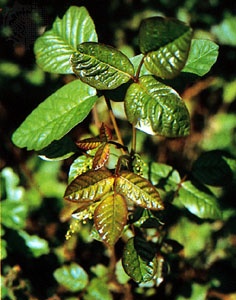 Many people know Anacardiaceae because of the dermatitis caused by the resins of some species. The most notorious probably are Toxicodendron diversiloba (poison oak) of western North America and T. radicans ( poison ivy) and T. vernix (poison sumac) of eastern North America. (Toxicodendron means “poison tree.”) The resin will disperse in the smoke of the burning wood of these plants and may even volatilize from their tissues on hot, dry days. Toxicodendron species used to be included in the genus Rhus, and they still sometimes appear under that genus name, but they differ from Rhus in having abundant resin canals in the stems (these produce the resinous sap that can include the noxious compound urushiol or natural lacquers). Mangoes and cashew apples cause dermatitis in those sensitive to their resins, as do their wood or leaves. Many people are also sensitive to liquid lacquer or mastic.
Many people know Anacardiaceae because of the dermatitis caused by the resins of some species. The most notorious probably are Toxicodendron diversiloba (poison oak) of western North America and T. radicans ( poison ivy) and T. vernix (poison sumac) of eastern North America. (Toxicodendron means “poison tree.”) The resin will disperse in the smoke of the burning wood of these plants and may even volatilize from their tissues on hot, dry days. Toxicodendron species used to be included in the genus Rhus, and they still sometimes appear under that genus name, but they differ from Rhus in having abundant resin canals in the stems (these produce the resinous sap that can include the noxious compound urushiol or natural lacquers). Mangoes and cashew apples cause dermatitis in those sensitive to their resins, as do their wood or leaves. Many people are also sensitive to liquid lacquer or mastic. Burseraceae
Like some of the members of Anacardiaceae, most of the members of Burseraceae are known for their aromatic resins or gums. The most famous of these are Boswellia carteri and related species, the sources of frankincense, and Commiphora abyssinica and related species that yield myrrh. C. opobalsamum furnishes balm of Gilead. All grow naturally or are cultivated in arid areas, from Ethiopia to India, with other species that produce resins. They are also used in incense and perfumes. Resin collecting is an important part of the economy in Ethiopia and Somalia. In tropical America, Protium copal ( copal) and other members of Protium are tapped for their resins, which have been used in Central America as incense for religious purposes since pre-Columbian times. Likewise, Bursera simaruba (gumbo-limbo, or incense tree) and other members of Bursera are exploited for turpentine or elemi (an oily resin) in tropical America. Some contain such large amounts of resin and burn so fiercely that they are known as torchwoods (torchwood). Canarium strictum (Indian black dammar tree) and C. commune (Java almond) of Indo-Malaysia, a source of Manila elemi, also produce commercially valuable resins. The seed of the latter, which is cultivated in Australia, is edible, as are those of several other East Asian species, which also may be processed to produce cooking oil. The fruits of C. albumare are eaten like olives.
A few Burseraceae species are important timber trees. Probably the most important of these is Aucoumea klaineana (gaboon mahogany), from West Africa, used for veneers (veneer) and plywood (wood).
Simaroubaceae
Simaroubaceae is a family known for its medicinal plants, although Kirkia acuminata (southern African white syringa) has wood that is worked into veneer, furniture, flooring, or household articles. Decoctions of the bark and wood of Quassia amara (quassia wood) are used in tropical America to make an antimalarial tonic. This species is widely cultivated for its red flowers and bitter bark. Likewise, bitters are prepared from the bark of Simaba cedron in Central America and Picrasma excelsa (Jamaica quassia) in the West Indies. At one time, the bitter leaves and licorice-flavoured bark of the West Indian and Central American Picramnia antidesma (cascara amarga) were exported to Europe as a treatment for venereal disease. The astringent seeds of Brucea amarissima and B. sumatrana are used in Southeast Asia to treat dysentery.
Characteristic morphological features
Sapindales is overwhelmingly composed of woody plants—mostly trees, large shrubs, and woody climbers. The latter are particularly common in Sapindaceae (Paullinia, Serjania, and Urvillea) and Anacardiaceae (Toxicodendron). Many beautiful forest trees (tree) belong to this order. The largest trees are in Sapindaceae; they include Schleichera oleosa (Ceylon oak), which grows to 60 metres (almost 200 feet) in Myanmar (Burma), Pometia pinnata, which grows to 50 metres (about 165 feet) in New Guinea, and Tristiropsis canarioides, which grows to 45 metres (150 feet) in New Guinea. Several species of Anacardiaceae, such as the Old World tropical Campnosperma auriculata, Mangifera lagenifera, and Buchanania lucida, may reach heights of 33 metres (108 feet). In North America the sugar maple may grow to 35 metres (115 feet) high.
Most species of Sapindales have pinnately compound leaves (with the leaflets of each compound leaf arranged along both sides of a central axis). They are rarely palmately compound (the leaflets radiating from the petiole apex) or simple. Leaves are generally alternately arranged along a stem and are only rarely opposite or whorled. An interesting form of leaf is found in Citrus, where the simple blade is separated from the petiole by a joint. Because this type of leaf occurs in other genera of Rutaceae with compound leaves, it is believed that this is reduced from a compound form. Reduction goes still further in Citrus, in which the first one or two leaves of an axillary bud (a bud located in an axil, or upper angle, between a stem and a branch or leaf) are reduced to spines. Leaves of the Asian genus Chisocheton (family Meliaceae) show indeterminate or continuous growth. Stipules are usually absent from the leaves of members of Sapindales.
The flowers (flower) may be single in the axils of the leaves, or they may be arranged in racemes (spikelike clusters that bloom from the base upward), cymose spikes (clusters blooming from the top downward), or panicles (many-branched clusters). Flowers of most Sapindales appear to be pollinated (pollination) by insects. The coloured petals and sometimes stamens of many of these flowers make them conspicuous; fragrance makes others attractive to insects. The disk at the base of the pistil often secretes an abundance of nectar attractive to insects as well. In some species, cross-pollination is favoured by protandry (maturation of the stamens before the stigma of the same flower is receptive to pollen) or protogyny (the stigma matures first).
In a number of families and genera throughout the order, there is a strong tendency toward obligate cross-pollination through the progressive development away from the typical floral bisexuality (hermaphroditism), in which both sexes are present and functional in the same flower. This culminates in dioecism, a condition where male and female flowers in the species are borne on separate plants. Dioecism has evolved independently in most families. Many members of the order have bisexual and unisexual flowers on the same plant (polygamous). In some inflorescences, for example, the terminal flower is bisexual, while the others are all male or female. This combines the advantages of maximum fertility through inbreeding with increased variability through outcrossing. Many structurally bisexual flowers, as in many maples for example, are functionally unisexual, as either the stamens do not produce fertile pollen, the stigmas are not receptive, or the pistils do not contain ovules. Some species (e.g., Acer platanoides, Norway maple; A. saccharinum, silver maple; and A. spicatum, mountain maple) are self-sterile and must be outcrossed. Most unisexual flowers in the order have become that way after either the pistil or the stamens fail to mature, as the flowers often retain the rudimentary remains of the nonfunctional organ. Thus, although many species of Sapindales have insured cross-pollination and outbreeding, most have not achieved complete anatomical dioecism.
 Flowers in Sapindales are either radially or bilaterally symmetrical and are typically small, although there are a number of exceptions to the latter. Generally, both sepals and petals are present. They are usually free, but in some genera sepals may be fused into a calyx or petals into a corolla (e.g., the tropical American genera of Burseraceae, Tetragastris, and Trattinnickia). Petals may be lacking in some (e.g., Acer negundo, box elder).
Flowers in Sapindales are either radially or bilaterally symmetrical and are typically small, although there are a number of exceptions to the latter. Generally, both sepals and petals are present. They are usually free, but in some genera sepals may be fused into a calyx or petals into a corolla (e.g., the tropical American genera of Burseraceae, Tetragastris, and Trattinnickia). Petals may be lacking in some (e.g., Acer negundo, box elder).Stamens are usually double in number of petals, with an outer whorl opposite the sepals and an inner whorl opposite the petals. In some species they are equal to the number of petals and alternate with them, while in others there may be three whorls of stamens or a larger number with whorls that are difficult to distinguish. Filaments are usually free, but they may be fused into a tube in most members of Meliaceae and some members of Rutaceae. Anthers have two locules and open lengthwise. In species with unisexual flowers, staminodes (sterile stamens) are usually present in female flowers. There is almost always a nectar-producing disk between the stamens and the pistil.
The pistil is usually compound, but in a few groups (e.g., Zanthoxylum, Rutaceae) there are separate simple pistils in the flower. The ovary is almost always superior and is composed of 1 to 20 carpels. The ovary is usually multilocular, but it may be multilocular at the base and unilocular above in several members of Meliaceae. It is unilocular in simple pistils. Ovules are typically two per locule, although they may be one or several. Styles are usually united and the same number as the carpels. Functionally male flowers often contain a pistillode (sterile pistil).
The fruit in Sapindales is basically a capsule that splits open between the internal partitions, although it has been modified into a number of other types in most families. For example, in Rutaceae one finds capsules (e.g., Ruta, rue), follicles (Zanthoxylum, prickly ash), drupes (Amyris, torchwood), berries (Triphasia, limeberry), samaras ( hop tree), and schizocarps (Helietta, barreta). The fruit of Citrus is a modified berry with a thick rind called a hesperidium, after the golden apples of the Hesperides. In the myth of the Greek hero Heracles, one of Heracles' 12 labours was the fetching of the golden apples kept by the Hesperides. These mythical apples may well have been based upon oranges, which were not grown in the West in ancient times but which the Greeks may have been aware of because of their trade with the East.
When mature, the seeds of Sapindales may be with or without endosperm, the starchy nutrient tissue that supplies energy for the developing embryo. There are commonly one or two seeds per locule. Some genera of Rutaceae (e.g., Citrus and Zanthoxylum) and Anacardiaceae (Mangifera) contain many embryos in a single seed; these embryos may come from different parts of the ovule besides the fertilized egg. (The formation of an embryo from tissue other than the fertilized egg is called apomixis.) The seeds of Meliaceae are often winged and dispersed by wind. In many Sapindaceae and Burseraceae, the seed is surrounded by a colourful fleshy aril that is attractive to birds, which disperse these seeds. Most families have fleshy fruits attractive to mammals and birds and hard seeds that will pass through their alimentary canals (alimentary canal) without harm.
Evolution
The evolutionary relationships between the families placed in Sapindales, and between them and other orders, are becoming clarified on the basis of DNA sequence data, morphological resemblances, and chemistry. Sapindales is most closely related to Malvales, Brassicales, and Huertales. Sapindales consists of basically three groups of related families. One group includes the families Rutaceae, Meliaceae, and Simaroubaceae, which share a nectary disk between the anthers and carpels and similar secondary compounds. The second group consists of Anacardiaceae, Burseraceae, and Kirkiaceae, which share small flowers. The third group includes Sapindaceae. Previously recognized families of Aceraceae (maples) and Hippocastanaceae (horse chestnuts) have been shown to be closely related temperate offshoots from within the largely tropical Sapindaceae. In addition, there are two ungrouped families: Biebersteiniaceae and Nitrariaceae.
- Satun
- saturation
- Saturday
- Saturday Night Live
- Saturn
- Saturnian verse
- saturniid moth
- Saturninus, Lucius Appuleius
- satyagraha
- Satyajit Ray
- Satyasiddhi-śāstra
- Satyendra Nath Bose
- Satyendra Prassano, 1st Baron Sinha of Raipur Sinha
- Satyendra Prassano Sinha, 1st Baron Sinha of Raipur
- Satyr and Silenus
- satyr butterfly
- Satyricon
- satyr play
- Satō Eisaku
- Satō Haruo
- Satō Nobuhiro
- Saubel, Katherine Siva
- sauce
- sauceboat
- Saucesian Stage